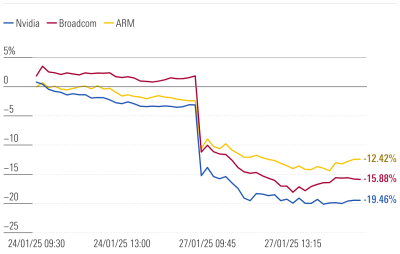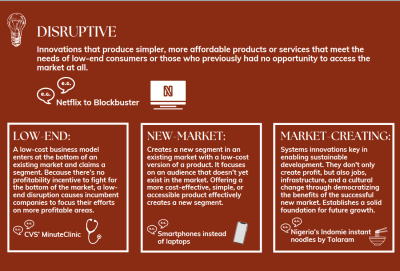On the 10th of January 2025, a hedge fund released an artificial intelligence (AI) app into the wild. By the 27th, the world responded to DeepSeek, as the AI is known, by crashing the value of AI related stocks, creating losses totaling more than a trillion dollars. Its very existence in the market has called into question the entire AI investment stack, including energy companies planning to expand to cater to expected demand.

“Despite its limitations, the ability to recreate an advanced AI model for such a small cost has once again raised questions about the current funding models of US tech giants, who have spent hundreds of billions of dollars developing their most advanced models.”
(Berkeley research demystifies DeepSeek and makes AI more accessible, 3 February 2025)
DeepSeek’s disruption of the market is not in doubt. However, does it qualify as a disruptive innovation? Or, as many detractors are saying, is it just a cheap Chinese imitation of fancier Western innovation?
Clayton Christensen, the late Harvard Business School professor, theorized the notion of an innovation released into the market that significantly disrupts its own industry and sector, as well as the market itself, and – crucially – is much more affordable and accessible than incumbents.

Three factors characterize a disruptive innovation, which we can use as evaluation criteria for DeepSeek by re-articulating them as questions:
Is it a low-cost business model entering the bottom of an existing market?
Yes.
DeepSeek’s low cost business model not only disrupted the pricing strategies of competitors in its home market of China, when it was first released in May 2024, but as evidenced, its existence and performance also disrupts assumptions regarding the amount of resources and energy AI requires, including the need for expensive high-powered chips. It is a solution developed within the confines of an extremely constrained product development strategy, that minimizes resources and inputs while maximizing performance and outputs. I described this approach to ‘design for the future‘ succinctly in May 2007, although nuances have naturally evolved over the years. That is, one can call this a resource-optimized innovation strategy.
“The fact that it comes out of China shows that being efficient with your resources matters more than compute scale alone,” (source)
Does it create a new segment (of customers) in an existing market with a low cost version of a product?
Yes.
DeepSeek hasn’t released the full cost of training R1, but it is charging people using its interface around one-thirtieth of what o1 costs to run. The firm has also created mini ‘distilled’ versions of R1 to allow researchers with limited computing power to play with the model. An “experiment that cost more than £300 [US$370] with o1, cost less than $10 with R1,” says Krenn. “This is a dramatic difference which will certainly play a role in its future adoption.” (Nature, 30 January 2025)
Scientific research is not the only customer segment being opened where resources are scarce. Its open source model permits adaptation to any number of locations with similar constraints in costs and technology. Recent experiments running it on Raspberry Pi, for example, point to a future development trajectory that can incorporate AI computing power to answer questions of uncertainty that face subsistence farmers facing volatile climatic conditions. Making the code available on Github also opens doors to indigenous innovations customized for the unique and peculiar problems such as biodiversity management in the heart of the Congo Basin or more prosaic applications in lower income markets. Where businesses had to carefully consider the costs of AI due to lower purchasing power and investment capacity is everywhere that this solution can be applied, or at least experimented with for possible applications.
Is it a market-creating innovation at the systems level i.e. is there potential for enabling sustainable development of markets, customers, applications, products, and services on the foundation of its business model?
Yes.
Or, rather, its on its way to doing so and it will. Simply because it solves a number of engineering problems. That is, even I can tell that the team involved is innovating a number of elegant solutions to long established problems in AI development that rely on a more thoughtful and sensitive approach to problem solving rather than a brute force application of ever-increasing resources such as computing power, energy, and expensive talent.
“I’ve heard many people express the sentiment that the DeepSeek team has “good taste” in research. Based just on these architectural improvements I think that assessment is right. None of these improvements seem like they were found as a result of some brute-force search through possible ideas. Instead, they look like they were carefully devised by researchers who understood how a Transformer works and how its various architectural deficiencies can be addressed.” (Ege Erdil, 17 January 2025)
An indepth interview with DeepSeek’s CEO published in November 2024 offers more insight:
“DeepSeek was quickly dubbed the “Pinduoduo of AI,” and other major tech giants such as ByteDance, Tencent, Baidu, and Alibaba couldn’t hold back, cutting their prices one after another. A price war for large models in China was imminent.
This diffuse smoke of war actually concealed one fact: unlike many big companies burning money on subsidies, DeepSeek is profitable.”
And, this was months before it launched its free to use open-source model accessible in English to the rest of the world.
My concluding remarks at this very early stage
Unlike the majority of commentators online, I do not see DeepSeek’s emergence on the public stage from a political or ideological angle. While these factors certainly played their part in creating the design constraints for the architecture and forcing innovation that maximized ROI from minimized inputs – its the optimization strategy and its resulting performance that are impressive. This may also contribute to their business model decision to go open source, since its affordable to do so. As the interview linked above says, DeepSeek was profitable unlike the rest of the market. That itself is clear evidence that it met all of Chrisensen’s critera for a disruptive innovation.

